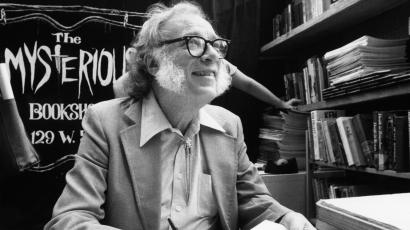Innovate Like Isaac Asimov – Lessons from An Innovator Years Ahead of His Time
 It should be no surprise that innovation is a constantly evolving field. As innovators, it is in our nature to constantly evaluate, optimize and reinvent our models and processes. Indeed, how can we expect to help our clients to evolve and reinvent their products and services if we cannot continuously improve our own?
It should be no surprise that innovation is a constantly evolving field. As innovators, it is in our nature to constantly evaluate, optimize and reinvent our models and processes. Indeed, how can we expect to help our clients to evolve and reinvent their products and services if we cannot continuously improve our own?
However, sometimes it is also good to look back. To paraphrase Dennis Gabor, we cannot hope to invent the future without understanding how the past invented the present.
I recently reread a 1959 article on innovation by the late, great Isaac Asimov. It was both humbling and inspiring to see a master discuss over 50 years ago so much of what is current in our discussion around innovation and creativity today. In particular, he describes so many of the insights that we today draw from our understanding of behavioral science and psychology. A lot of the terminology and linguistics may have changed over the years, but the core ideas he described remain insightful and current today: In particular, four key insights stand out.
1.Why didn’t I think of that? One of the best measures of a great idea is its obviousness in hindsight.  Referring to Darwin’s “The Origin of the Speciesâ€, arguably one of the greatest scientific discoveries of all time, Asimov quotes Thomas Huxley, who is supposed to have said, “How stupid of me not to have thought of thisâ€. “Why didn’t I think of that†to this day remains a simple, and very effective measure of any innovation. So many great inventions seem obvious in hindsight, be it Uber, the iPad or even the wheel! But before they were obvious, they weren’t! Even if we are not in the same league as Darwin, whether or not an innovation is ‘surprisingly obvious’ is still a powerful way to evaluate it. If it passes the ‘why didn’t I think of that’ test, we almost certainly have a winner, one which possesses the magic combination of authentic added value, while also being easy to understand (and hence market).
2.  The ability to bridge across domains and silos. Truly disruptive, game changing ideas rarely come from the existing center of expertise. As Max Planck put it, ‘science progresses one funeral at a time’, and indeed the biggest barriers to new ideas are often the deeply entrenched ideas and expertise that precedes them. Today we often talk about the value of T-Shaped innovators. This is a term originally coined by Tim Brown at IDEO to describe people who have deep knowledge in one domain, but whose curiosity and broad knowledge of a wide variety of areas helps them to connect the dots in surprising ways, and reapply knowledge across domains and silos. This is central to so many great innovations. How many lives did Alexis Carrel save with his Nobel Prize winning suturing techniques used in heart surgery, a technique he reapplied from lace making? The now almost ubiquitous, and very profitable Autotune technology used in the recording industry, and made famous by Cher and Kanye West, was reapplied from reflection seismology used in oil exploration by Andy Hildebrand.  The list goes on, James Dyson reapplied cyclonic separation from a saw mill to create his vacuum cleaner, while the relatively simple concept of “Uberization†has been reapplied to create so many new businesses in the last few years. Asimov was way ahead of the curve on this, and in deconstructing the Origin of the Species, he described what are essentially T-shaped innovators with the ability to bridge across domains and silos, “what you needed was someone who studied species, read Malthus, and had the ability to make a cross-connectionâ€
3. Parallel Discovery. One of the most important things any innovator can do is to stay current within our own field. While stretching across domains to become ‘T-Shaped’ is a powerful way to expand our capability, remaining anchored in our core expertise is non negotiable. This sounds obvious, but as the sheer volume of information in virtually every field explodes, it is no small task. In reality, for many of us this means constantly revising the scope of our core knowledge area, and/or finding networking and sharing strategies to help us to remain current without getting overwhelmed by the sheer volume of new information available to us everyday. However, if we don’t stay current, we risk being outflanked by parallel discovery. In essence, this is when a discovery becomes almost inevitable, simply because all of the pieces of a puzzle have recently come into place. (Very) smart people will inevitably see patterns emerging from combinations of other recent discoveries, and connect them to make what become almost inevitable discoveries.  We see this epitomized in numerous shared Nobel prizes, or simply in similar patents that culminate years of work, but are often filed within a few days of each other. Examples of big scientific discoveries that fit this model include the parallel discovery of epigenetics by Holliday, Pugh and Riggs in the 1980’s, and the classic parallel discoveries of calculus (Newton and Leibonitz) and natural selection (Darwin and Wallace) described by Asimov. However, parallel discovery does not apply only to great, world changing innovations like these. It also applies on a smaller scale, and I’ve personally experienced both the good and bad side of patents for commercial applications filed within a few days of each other. Fail to stay current, and what appears a huge challenge to us may become obvious to a smart competitor whose only advantage is access to new information provided by a more up to date reading list.
4. Deconstructing the Innovation Process. Finally, Asimov describes what may be the biggest challenge of all; deconstructing (and hence understanding and systematizing) the innovation process itself. We have plenty of examples of great innovations that we can analyze and post rationalize, but as he points out, “the method of generation (of ideas) is never clear even to the generators themselvesâ€.  We are rarely, if ever, able to observe the ‘act of creation’ in real time, and so have to rely on post rationalizations, memories, and post facto analysis of these events. We can certainly gain insight from this, and I believe that the transfer and hybridization of concepts between domains and at interfaces, and the intuitive use of analogy to facilitate this lies at the heart of the creative, innovative process. This kind of understanding can help us to be better innovators, and can allow us to create conditions where innovation is more likely to occur. But the Holy Grail of reliable, predictable, systematic innovation still remains a challenge, and probably will do for quite some time.
Image credit: qz.com
Wait! Before you go…
Choose how you want the latest innovation content delivered to you:
- Daily — RSS Feed — Email — Twitter — Facebook — Linkedin Today
- Weekly — Email Newsletter — Free Magazine — Linkedin Group
 A twenty-five year Procter & Gamble veteran, Pete Foley has spent the last 8+ years applying insights from psychology and behavioral science to innovation, product design, and brand communication. He spent 17 years as a serial innovator, creating novel products, perfume delivery systems, cleaning technologies, devices and many other consumer-centric innovations, resulting in well over 100 granted or published patents. Follow him @foley_pete
A twenty-five year Procter & Gamble veteran, Pete Foley has spent the last 8+ years applying insights from psychology and behavioral science to innovation, product design, and brand communication. He spent 17 years as a serial innovator, creating novel products, perfume delivery systems, cleaning technologies, devices and many other consumer-centric innovations, resulting in well over 100 granted or published patents. Follow him @foley_pete
NEVER MISS ANOTHER NEWSLETTER!
LATEST BLOGS
Three things you didn’t know about credit cards
Photo by Ales Nesetril on Unsplash Many of us use credit cards regularly. From using them for everyday purchases to…
Read MoreFive CV skills of a business-minded individual
Photo by Scott Graham on Unsplash The skills listed on a CV help employers quickly understand your suitability for a…
Read More


